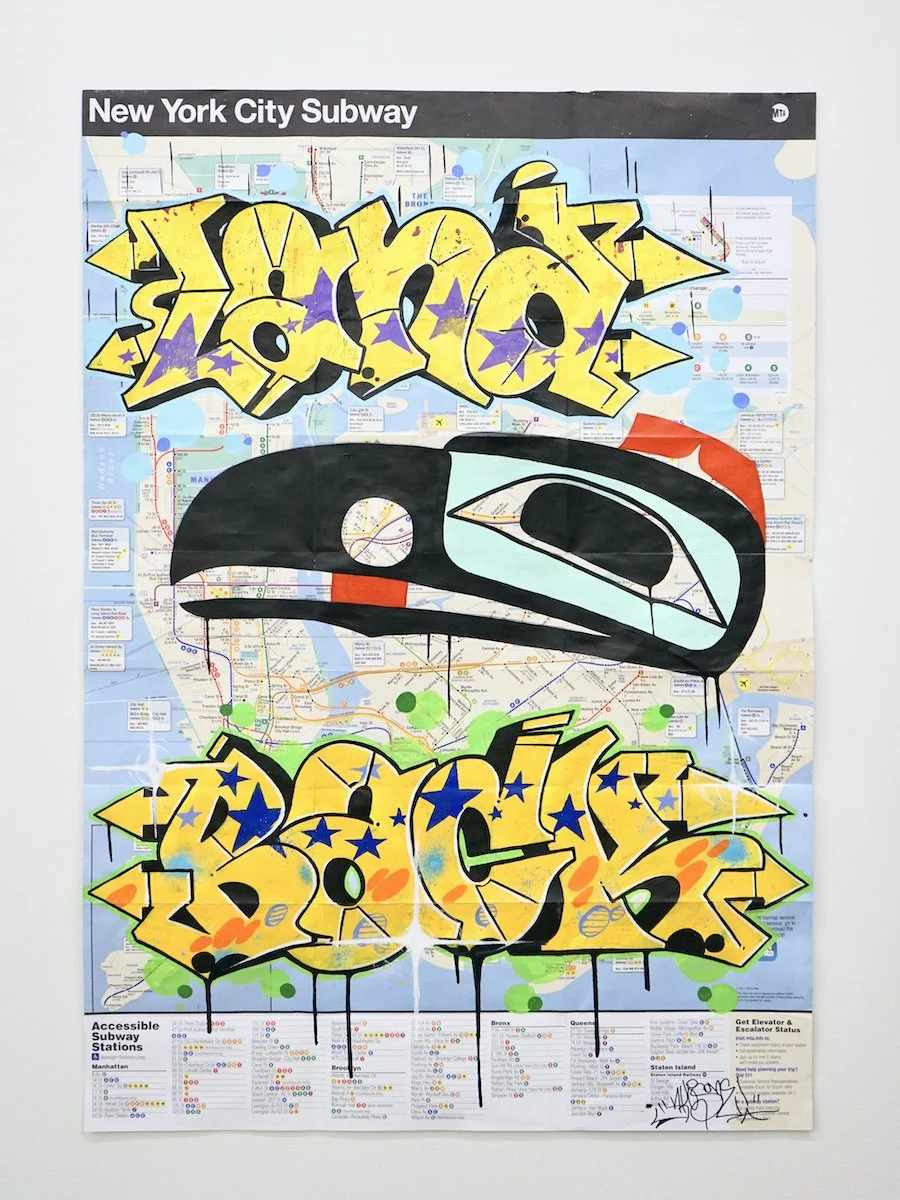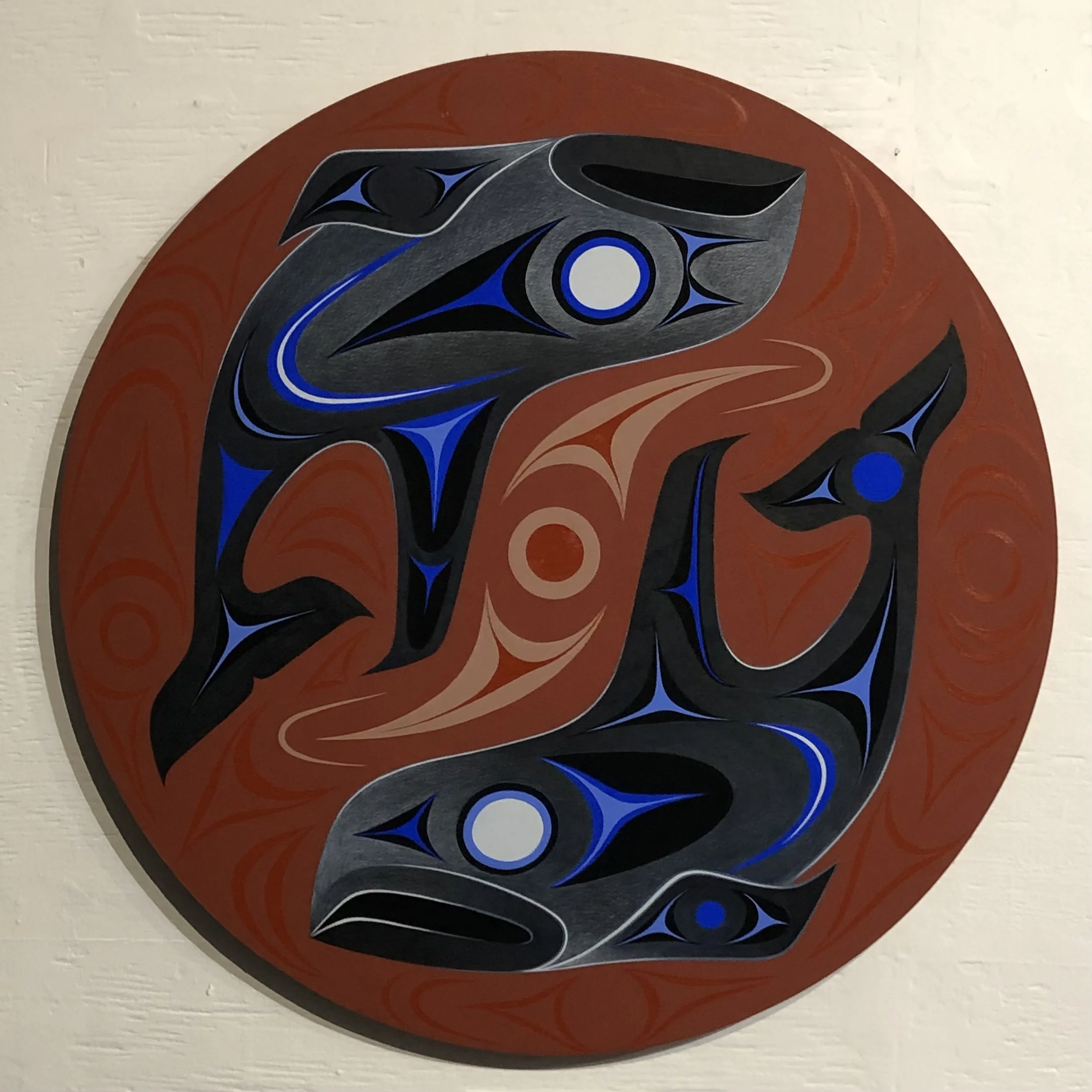True to Place: stímetstexw tel xéltel paints an innovative future for Northwest Coast art
Luke Parnell, Shawn Hunt, Corey Bulpitt, and more push the boundaries of tradition at the Bill Reid Gallery
Luke Parnell’s The Drums Are Calling, acrylic on canvas. Private Collection
Corey Bulpitt’s Raven Who Kept Walking, acrylic on New York Subway map. Collection of the Artist
Bill Reid Gallery of Northwest Coast presents True to Place: stímetstexw tel xéltel until March 19, 2023
BREAKDANCER-SUPERHEROES and ravens, Land Back graffiti and ceremonial rattles: the age-old and the cutting-edge-contemporary meet in stunning form in the Bill Reid Gallery of Northwest Coast Art’s new exhibit.
Some of the painters here use traditional techniques to address ripped-from-today’s-headlines issues. Icon Robert Davidson has emblazoned an intricately woven, spruce-root Haida hat with a bright red, blue, and green design that suggests the possibilities for a new world after the pandemic; Kwakwaka’wakw artist Steve Smith paints a smooth, spiralling wooden vessel in formline pinks, purples, lime, and teal, to inspire post-COVID hope. Responding to the Every Child Matters movement, Nisga’a/Haida artist Luke Parnell’s The Drums Are Sounding renders a strong and surreal drum procession in yellow, red-ochre, and black, facing injustice head-on.
Curated by Stó:lō artist and muralist Xémontalót Carrielynn Victor, the exhibit, called True to Place: stímetstexw tel xéltel, spotlights 10 Indigenous painters inspired by place-based stories and contemporary themes, while using new tools and forms of expression; some of the artists even employ digital drawing. “Stímetstexw tel xéltel” roughly translates in the Upriver Stahlo, Halq’emeylemqel dialect as “Keeping the pencil moving forward.” That’s a fitting theme for a show that is all about Indigenous painters who are taking Northwest Coast work into an exciting future, while deeply respecting and drawing on the past and its old stories.
“It’s moving in the best way we can forward, with the best tools of the day,” explains Victor, who also studies language, on an exhibit tour at the gallery. “Indigenous artists have historically and persistently seized any new tools at hand as a means of expression, moving forward in their practice from a place of history, tradition, and storytelling.”
Curator and artist Carrilynn Victor. Photo by Mavreen David
In commissioning the new works that make up most of the show, Victor asked the artists to use the thousands-of-years-old red-ochre pigment that comes from the land here—although some mix it with unexpected hues like neon-yellow.
“There’s a rich cultural understanding about what that colour means, where it comes from, and how to use it, so I’m so excited to see artists using it in different ways,” Victor says.
Local Salish artist Atheana Picha applies that ochre as a background for the striking cobalt blue of trader beads in the whorl-like-circular Blue-blackfish. The work refers to cultural wealth and exchange—the cobalt trader beads are thought to have arrived to the Indigenous people here from Russia or Czech Republic). So it’s fitting it features two mirror-image orcas, who also journey great distances.
Atheana Picha’s Blue-blackfish, 2022, mixed media. Collection of the Artist
“People think of Northwest Coast art as having a limited palette, but Coast Salish work is actually quite colourful,” comments Picha at the gallery.
Other standout pieces include Bulpitt’s brand-new, wall-filling and multilayered graffiti piece, Untitled, featuring spray-painted “Land Back” script with formline ovoids and other figures. As Victor says, “It’s speaking to current and ongoing political matters that Indigenous folks face, in the face of growing cities and spiralling suburbs that encroach on Indigenous space.” The same goes for Bulpitt’s Raven Who Kept Walking, graffiti and formline emblazoning a New York Subway map.
Elsewhere, Luke Parnell’s digital painting Break’n is a homage to American comic-book artist Jack Kirby, through an Indigenous lens; dressed in formline sneakers, a superhero cape, and an outsized ceremonial Coastal headdress, the character looks ready to leap out of the frame.
A few of Shawn Hunt’s stark, black, white, and blue-grey-tone paintings of moonlit spirit figures also show painting traditions in new ways; in one, the artist of Heiltsuk, French, and Scottish ancestry depicts an eerily stylized Raven lying, in human form, on his back, lifting his brush to paint the stars onto the open canvas of a black sky.
Like the artists here, the Raven in Hunt's dreamlike painting exists in a state of perpetual creation, transformation, and innovation—a cosmos of possibility waiting at the tip of his brush. It's a beautiful and more-than-fitting metaphor for the evolving world of contemporary Northwest Coast art on view here.
















